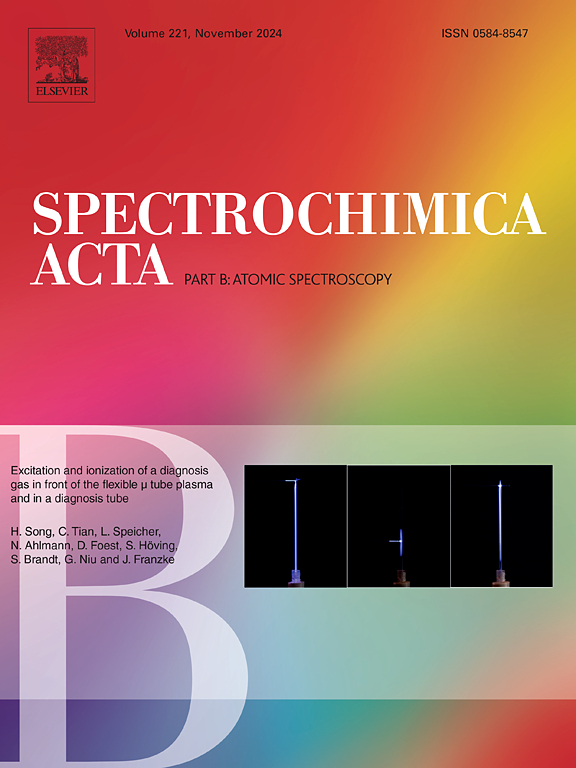使用开源机器学习对1942年不同地质标准中28种元素的经验便携式x射线荧光定量限制和精度
IF 3.8
2区 化学
Q1 SPECTROSCOPY
引用次数: 0
摘要
便携式x射线荧光(pXRF)仪器通常用于量化材料中的元素,因为它们的便携性和使用基本参数方法和数据库的快速结果。还可以通过组装替代数据库来定制结果,而不是这些系统通常提供的包含校准。相比之下,本文提出了标准基本参数(FP)协议的替代方法。相反,我们使用基于1942年地球化学标准的多元(MVA)方法直接从pXRF光谱中定量元素丰度。给出了6种主要元素(Al2O3、CaO、Fe2O3、MgO、SiO2、TiO2)、2种次要元素(MnO、P2O5)和20种微量元素(As、Bi、Cr、Cu、Mo、Nb、Ni、Pb、Rb、SO3、Sn、Sr、Ta、Th、U、V、W、Y、Zn、Zr)的预测精度(RMSE-P)和定量限(LOQ)。从ElasticNet、Ridge、OMP、PCR、LASSO等5种线性方法中,选择偏最小二乘(PLS)回归作为最佳的MVA方法。由此产生的MVA模型具有可与基于仪器的FP校准相媲美的精度,并且对低浓度更敏感。这项工作展示了一种强大且适应性强的开源方法,用于使用XRF光谱定量元素,应被视为传统FP方法的可行替代方案。这里使用的大型和多样化的地球化学数据集是公开的,以鼓励进一步的研究和数据集与校准转移的结合。本文章由计算机程序翻译,如有差异,请以英文原文为准。

Empirical portable x-ray fluorescence quantification limits and accuracies for 28 elements within 1942 diverse geological standards using open-source machine learning
Portable X-Ray Fluorescence (pXRF) instruments are commonly used to quantify elements within materials due to their portability and quick results using a fundamental parameters approach and a data library. Results can also be customized by assembling alternative data libraries instead of the included calibrations that are typically provided with such systems. In contrast, this paper presents an alternate approach to the standard fundamental parameters (FP) protocol. We instead empirically quantify elemental abundances directly from pXRF spectra using multivariate (MVA) methods trained on 1942 geochemical standards. Prediction accuracies (RMSE-P) and limits of quantification (LOQ) are presented for six major (Al2O3, CaO, Fe2O3, MgO, SiO2, TiO2), two minor (MnO, P2O5), and 20 trace elements (As, Bi, Cr, Cu, Mo, Nb, Ni, Pb, Rb, SO3, Sn, Sr, Ta, Th, U, V, W, Y, Zn, Zr). Partial least squares (PLS) regression was chosen as the optimal MVA method from five other linear methods (ElasticNet, Ridge, OMP, PCR, LASSO). The resultant MVA models have accuracies comparable to instrument-based FP calibrations, and are more sensitive to low concentrations. This work demonstrates a powerful and adaptable open-source method for quantifying elements using XRF spectra that should be considered as a viable alternative to traditional FP approaches. The large and diverse geochemical dataset used here is made publicly available to encourage further study and combination of datasets with calibration transfer.
求助全文
通过发布文献求助,成功后即可免费获取论文全文。
去求助
来源期刊
CiteScore
6.10
自引率
12.10%
发文量
173
审稿时长
81 days
期刊介绍:
Spectrochimica Acta Part B: Atomic Spectroscopy, is intended for the rapid publication of both original work and reviews in the following fields:
Atomic Emission (AES), Atomic Absorption (AAS) and Atomic Fluorescence (AFS) spectroscopy;
Mass Spectrometry (MS) for inorganic analysis covering Spark Source (SS-MS), Inductively Coupled Plasma (ICP-MS), Glow Discharge (GD-MS), and Secondary Ion Mass Spectrometry (SIMS).
Laser induced atomic spectroscopy for inorganic analysis, including non-linear optical laser spectroscopy, covering Laser Enhanced Ionization (LEI), Laser Induced Fluorescence (LIF), Resonance Ionization Spectroscopy (RIS) and Resonance Ionization Mass Spectrometry (RIMS); Laser Induced Breakdown Spectroscopy (LIBS); Cavity Ringdown Spectroscopy (CRDS), Laser Ablation Inductively Coupled Plasma Atomic Emission Spectroscopy (LA-ICP-AES) and Laser Ablation Inductively Coupled Plasma Mass Spectrometry (LA-ICP-MS).
X-ray spectrometry, X-ray Optics and Microanalysis, including X-ray fluorescence spectrometry (XRF) and related techniques, in particular Total-reflection X-ray Fluorescence Spectrometry (TXRF), and Synchrotron Radiation-excited Total reflection XRF (SR-TXRF).
Manuscripts dealing with (i) fundamentals, (ii) methodology development, (iii)instrumentation, and (iv) applications, can be submitted for publication.

 求助内容:
求助内容: 应助结果提醒方式:
应助结果提醒方式:


